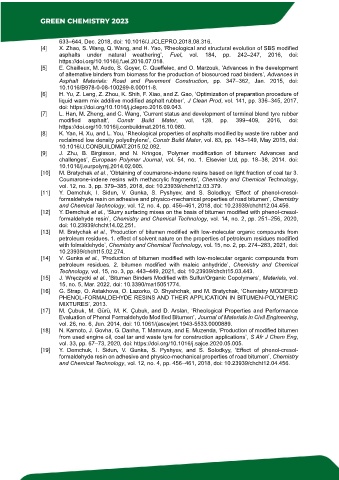Page 417 - GreenChemistry2023 Emhetgel
P. 417
633–644, Dec. 2018, doi: 10.1016/J.JCLEPRO.2018.08.316.
[4] X. Zhao, S. Wang, Q. Wang, and H. Yao, ‘Rheological and structural evolution of SBS modified
asphalts under natural weathering’, Fuel, vol. 184, pp. 242–247, 2016, doi:
https://doi.org/10.1016/j.fuel.2016.07.018.
[5] E. Chailleux, M. Audo, S. Goyer, C. Queffelec, and O. Marzouk, ‘Advances in the development
of alternative binders from biomass for the production of biosourced road binders’, Advances in
Asphalt Materials: Road and Pavement Construction, pp. 347–362, Jan. 2015, doi:
10.1016/B978-0-08-100269-8.00011-8.
[6] H. Yu, Z. Leng, Z. Zhou, K. Shih, F . Xiao, and Z. Gao, ‘Optimization of preparation procedure of
liquid warm mix additive modified asphalt rubber’, J Clean Prod, vol. 141, pp. 336–345, 2017,
doi: https://doi.org/10.1016/j.jclepro.2016.09.043.
[7] L. Han, M. Zheng, and C. Wang, ‘Current status and development of terminal blend tyre rubber
modified asphalt’, Constr Build Mater, vol. 128, pp. 399–409, 2016, doi:
https://doi.org/10.1016/j.conbuildmat.2016.10.080.
[8] K. Yan, H. Xu, and L. You, ‘Rheological properties of asphalts modified by waste tire rubber and
reclaimed low density polyethylene’, Constr Build Mater, vol. 83, pp. 143–149, May 2015, doi:
10.1016/J.CONBUILDMAT.2015.02.092.
[9] J. Zhu, B. Birgisson, and N. Kringos, ‘Polymer modification of bitumen: Advances and
challenges’, European Polymer Journal, vol. 54, no. 1. Elsevier Ltd, pp. 18–38, 2014. doi:
10.1016/j.eurpolymj.2014.02.005.
[10] M. Bratychak et al., ‘Obtaining of coumarone-indene resins based on light fraction of coal tar 3.
Coumarone-indene resins with methacrylic fragments’, Chemistry and Chemical Technology,
vol. 12, no. 3, pp. 379–385, 2018, doi: 10.23939/chcht12.03.379.
[11] Y. Demchuk, I. Sidun, V. Gunka, S. Pyshyev, and S. Solodkyy, ‘Effect of phenol-cresol-
formaldehyde resin on adhesive and physico-mechanical properties of road bitumen’, Chemistry
and Chemical Technology, vol. 12, no. 4, pp. 456–461, 2018, doi: 10.23939/chcht12.04.456.
[12] Y. Demchuk et al., ‘Slurry surfacing mixes on the basis of bitumen modified with phenol-cresol-
formaldehyde resin’, Chemistry and Chemical Technology, vol. 14, no. 2, pp. 251–256, 2020,
doi: 10.23939/chcht14.02.251.
[13] M. Bratychak et al., ‘Production of bitumen modified with low-molecular organic compounds from
petroleum residues. 1. effect of solvent nature on the properties of petroleum residues modified
with folmaldehyde’, Chemistry and Chemical Technology, vol. 15, no. 2, pp. 274–283, 2021, doi:
10.23939/chcht15.02.274.
[14] V. Gunka et al., ‘Production of bitumen modified with low-molecular organic compounds from
petroleum residues. 2. bitumen modified with maleic anhydride’, Chemistry and Chemical
Technology, vol. 15, no. 3, pp. 443–449, 2021, doi: 10.23939/chcht15.03.443.
[15] J. Wręczycki et al., ‘Bitumen Binders Modified with Sulfur/Organic Copolymers’, Materials, vol.
15, no. 5, Mar. 2022, doi: 10.3390/ma15051774.
[16] G. Strap, O. Astakhova, O. Lazorko, O. Shyshchak, and M. Bratychak, ‘Chemistry MODIFIED
PHENOL-FORMALDEHYDE RESINS AND THEIR APPLICATION IN BITUMEN-POLYMERIC
MIXTURES’, 2013.
[17] M. Çubuk, M. Gürü, M. K. Çubuk, and D. Arslan, ‘Rheological Properties and Performance
Evaluation of Phenol Formaldehyde Modified Bitumen’, Journal of Materials in Civil Engineering,
vol. 26, no. 6, Jun. 2014, doi: 10.1061/(asce)mt.1943-5533.0000889.
[18] N. Kamoto, J. Govha, G. Danha, T . Mamvura, and E. Muzenda, ‘Production of modified bitumen
from used engine oil, coal tar and waste tyre for construction applications’, S Afr J Chem Eng,
vol. 33, pp. 67–73, 2020, doi: https://doi.org/10.1016/j.sajce.2020.05.005.
[19] Y. Demchuk, I. Sidun, V. Gunka, S. Pyshyev, and S. Solodkyy, ‘Effect of phenol-cresol-
formaldehyde resin on adhesive and physico-mechanical properties of road bitumen’, Chemistry
and Chemical Technology, vol. 12, no. 4, pp. 456–461, 2018, doi: 10.23939/chcht12.04.456.

